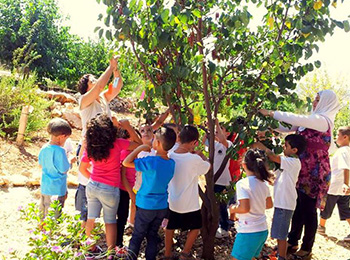In an effort to raise money for their network of bilingual, Jewish and Arab co-educational schools, representatives from Israel’s Hand in Hand: the Centre for Jewish-Arab Education toured several North American cities recently to meet potential donors.
Rebecca Bardach, Hand in Hand’s director of resource development and strategy, and Mohamad Marzouk, director of its community department, ended their tour last month in Toronto, where they met privately with individuals and community groups interested in supporting their cause.
“We receive core government funding,” said Bardach, “but to make our model possible we also rely on parent fees and philanthropy.”
Hand in Hand, which was founded in 1997, has five schools, located in communities in Jerusalem, the Galilee, Wadi Ara, Jaffa and Haifa.
The organization’s flagship school, the Max Rayne Hand in Hand Jerusalem School, opened in 1998, and since 2008 has operated out of a campus in southern Jerusalem between the Arab community of Beit Safafa and the Jewish neighbourhood of Pat.
This school is largely supported by the Jerusalem Foundation, which promotes co-existence and equity for all residents of Jerusalem, and has fundraising operations in several countries, including Canada.
The Jerusalem school currently has about 620 students, with an approximate 60-40 split of Arab to Jewish students.
“Our goal for every classroom, school and community activity we run is a 50-50 ratio [of Jewish to Arab students],” Bardach said, noting that Hand in Hand’s two brand new preschools, in Haifa and Jaffa, both have a 50-50 breakdown in terms of their student populations and student waiting lists.
They also strive for a 50-50 split among staff, and in the younger grades, classes are often co-taught by Arab and Jewish teachers. Hand in Hand is looking to expand, and has launched a 10-year plan to open 10 to 15 more schools throughout Israel.
In addition to establishing schools where language, cultural and political barriers are broken down and Jewish and Arab students learn together, create friendships and, as Bardach put it, “learn to communicate with one another,” Hand in Hand wants to apply its model on a broader scale. It’s already made headway: each school functions as a launch pad for building infrastructure that bridges local Jewish and Arab communities.
For example, two years into a three-year grant from the U.S. government aid agency USAID, Hand in Hand has successfully organized language courses for Jewish and Arab adults to learn each other’s languages, as well as mixed dialogue groups to discuss social and political issues and a number of social activities, such as a Jewish-Arab basketball team and a women’s running group for Jewish and Arab adults.
“We want to break the segregation that happens, where each community lives in a segregated village or town,” Marzouk explained. “We hope that in creating these kinds of meetings with adults, we can create opportunities and frameworks to break down segregation even further.”
Bardach said the fruits of these efforts were demonstrated this past summer, as the war between Israel and Hamas precipitated anger and hatred on both sides.
During the conflict, the Jerusalem school organized weekly walks through the city, typically attended by 100 to 300 Jews and Arabs, who marched without posters or slogans, but simply with “the existential message that we want to be together,” she said.
“This comes from [Jews and Arab people] knowing each other, trusting each other… When it came to a time of war, we didn’t have to suddenly create these relationships, they were already there.”
Of course, the co-existence model isn’t without challenges, and neither are the schools immune to political tensions in the larger society. During the summer, the Jerusalem school was spray-painted with graffiti reading “Death to Arabs.”
The matter was immediately addressed in classes, and students responded by making a poster that said Jews and Arabs can be partners. “When relationships between the two communities are, at a national level, particularly tense, this tension comes to the school. So then we as a school have to support the children and parents in the hostile environment,” Bardach said.
Marzouk said the school’s educators have developed strategies to deal with conflict, and that many are about engaging in dialogue and being as open as possible.
The schools are publicly funded, but small parent fees, as well as donations, are needed to subsidize features such as special training for staff and to support Hand in Hand’s community outreach programs.
This fall, enrolment at all five schools was up by 10 per cent, and Bardach said their success is evident when one looks at the students’ social cohesion.
“These kids are growing up together. You see friendships across [Jewish-Arab] lines. If kids are arguing about something, it’s not about [political issues], but about any number of things kids argue about. They hang out, sleep over at each other’s houses. They maintain these friendships as they leave the school, as do their parents.”
